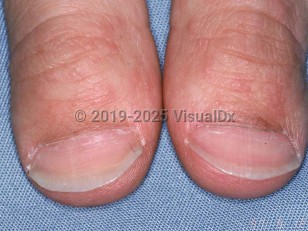Hereditary brachyonychia - Nail and Distal Digit
Alerts and Notices
Important News & Links
Synopsis

The term brachyonychia (racquet nail) refers to a short nail in which its width is greater than its length. The nail may also have prominent ridges, pigmentation, and an underlying shortened distal phalanx. Hereditary brachyonychia should be distinguished from the acquired form, which is typically secondary to onychophagia (nail biting) or, less frequently, due to underlying bone resorption in hyperparathyroidism and psoriatic arthropathy. Hereditary brachyonychia is due to the premature obliteration of the epiphyseal line of both thumbs. It is usually inherited as an autosomal dominant trait and may be associated with other congenital anomalies including facial abnormalities and intellectual disability. The female to male ratio is 3:1.
Codes
ICD10CM:
L60.8 – Other nail disorders
SNOMEDCT:
247488004 – Brachyonychia
L60.8 – Other nail disorders
SNOMEDCT:
247488004 – Brachyonychia
Look For
Subscription Required
Diagnostic Pearls
Subscription Required
Differential Diagnosis & Pitfalls

To perform a comparison, select diagnoses from the classic differential
Subscription Required
Best Tests
Subscription Required
Management Pearls
Subscription Required
Therapy
Subscription Required
References
Subscription Required
Last Updated:09/30/2018
Hereditary brachyonychia - Nail and Distal Digit

